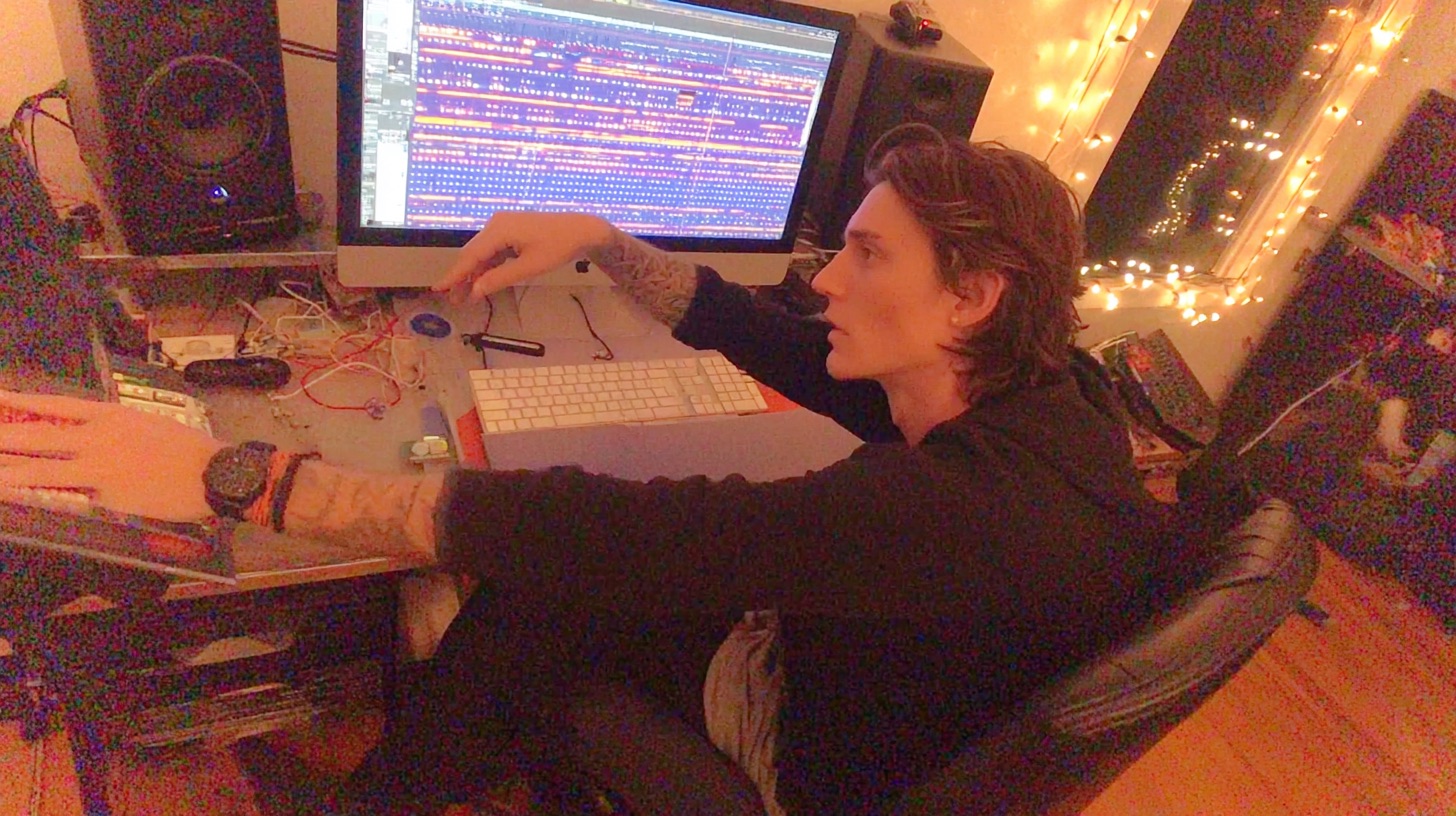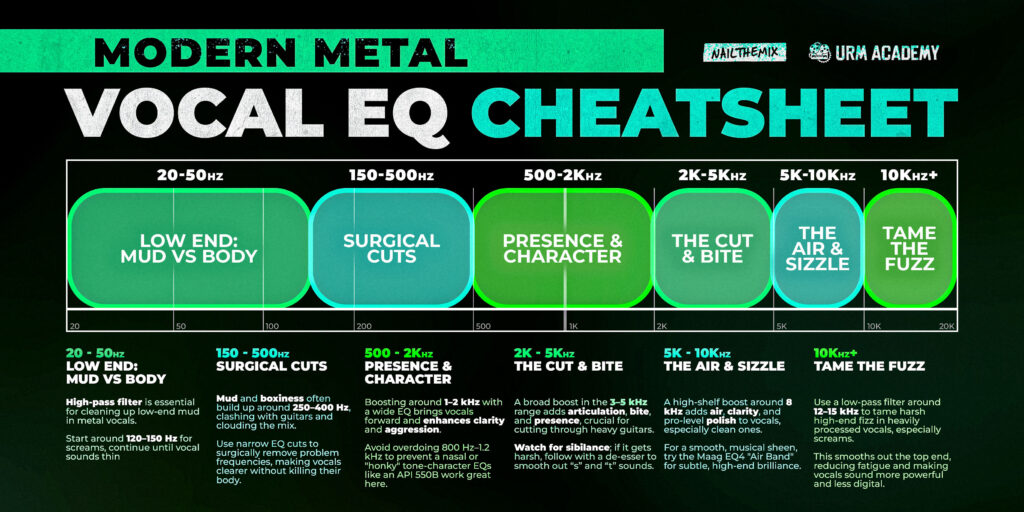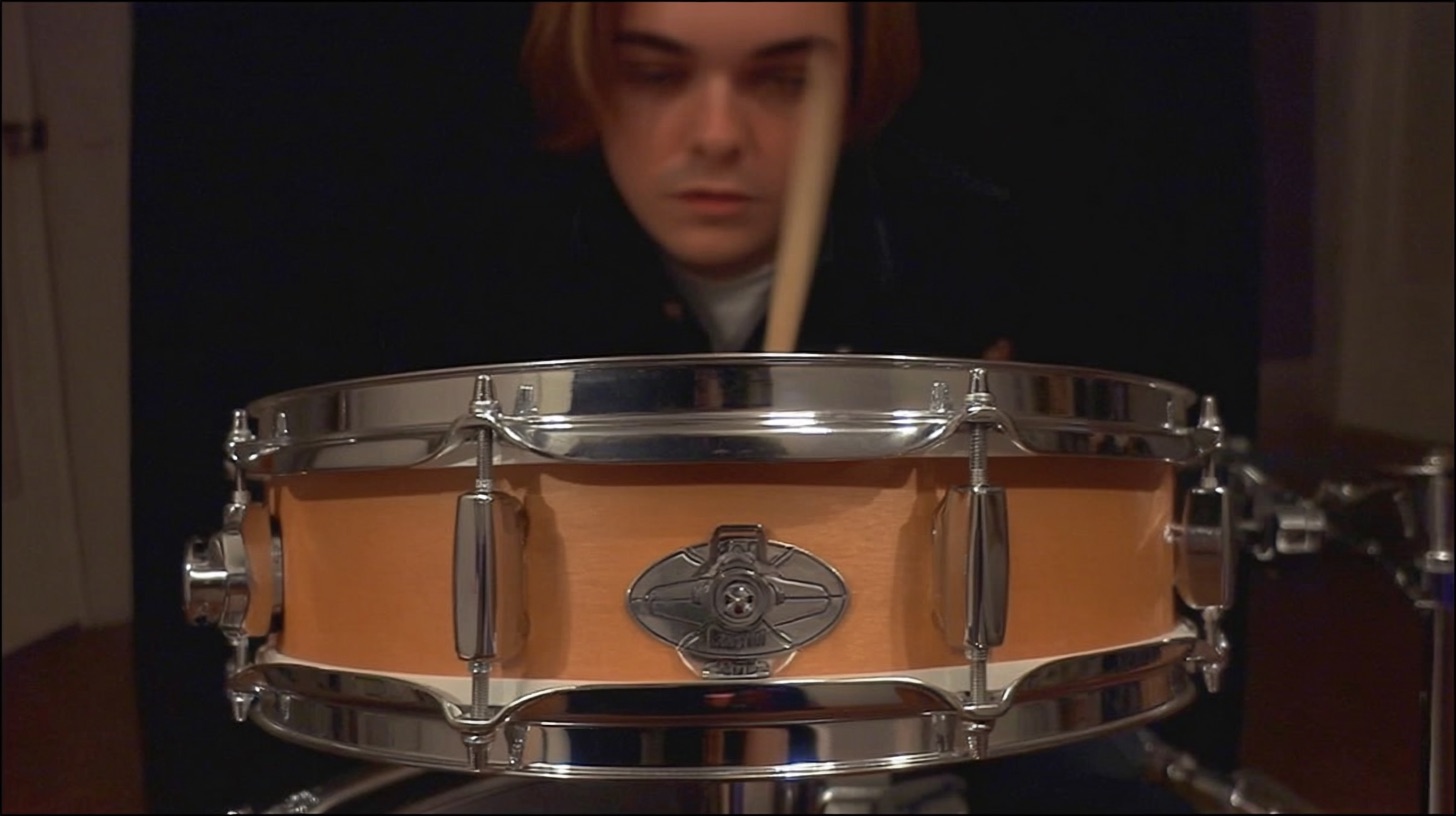
The Modern Metal Vocal EQ Cheat Sheet
Nail The Mix Staff
Mixing vocals in modern metal is a beast. You’ve got a wall of down-tuned, high-gain guitars, a bass that might as well be another guitar, and drums so punchy they could knock a hole in reality. How in the world do you get a vocal to not just sit in that mix, but to dominate it?
The answer isn’t some magic plugin or a single preset. It’s a game of inches, fought in the frequency spectrum with an EQ.
But let’s be real: anyone who tells you “always cut male vocals at 250Hz” or “boost every vocal at 5k” is selling snake oil. There are no universal rules. Every vocalist, every mic, and every song is a unique puzzle.
What we can give you are battle-tested starting points—a cheat sheet based on what actually works in dense, aggressive, polished metal mixes. These are the frequency zones the pros manipulate to take a vocal from a rough demo take to a release-ready weapon. Use these as your guide, but always let your ears make the final call.
Before You Touch an EQ: Get Your House in Order
You can’t EQ your way out of a bad recording. Before you even instantiate a plugin, make sure your foundation is solid.
- Gain Staging: Is your vocal recorded at a healthy level? Not clipping, but not so quiet you’re cranking the preamp into a noisy mess.
- Editing & Comping: Is the performance tight? Have you comped the best takes together?
- Initial Cleanup: Have you removed obvious mouth clicks, plosives, and unwanted background noise?
- Pre-EQ Compression: A little bit of initial compression can tame wild dynamics and give you a more consistent signal to EQ. Don’t slam it yet; just a few dB of gain reduction with a plugin like an 1176 or an LA-2A can work wonders. Check out our deep dive on metal compression for more on this.
Once that’s handled, it’s time to carve.
The Vocal EQ Cheat Sheet: Frequency Zones Explained
Think of the frequency spectrum in zones. Your job is to clean up the bad stuff and enhance the good stuff. For modern metal, that means creating space and then adding aggressive clarity so the vocal can fight through the instrumental density. Our go-to tool for this surgical work is often the FabFilter Pro-Q 3 for its transparency and killer visualizer.

Download the vocal EQ cheat sheet here
Low-End (20-150 Hz): Mud vs. Body
This is step one, and it’s non-negotiable for 99% of metal vocals.
- What it is: Rumble, mic stand vibrations, air conditioning hum, and low-frequency mud that clashes with your kick and bass.
- The Move: High-Pass Filter (HPF). This is your most powerful tool for cleaning up a mix.
- Starting Point: For aggressive screams and growls, start your HPF around 120-150 Hz. You’re not losing anything important up there. For clean male vocals, you can be more conservative, starting around 80-100 Hz to retain some chest resonance and body. For clean female vocals, you can often push the HPF even higher.
- Pro Tip: Listen in the context of the full mix. Push the filter up until the vocal starts to sound thin, then back it off just a touch. That’s your sweet spot.
Low-Mids (150-500 Hz): The Danger Zone
This is where vocals (and pretty much every other instrument) can sound muddy, boxy, or “woofy.” It’s also where the fundamental frequencies of your chunky, low-tuned guitars live. You need to clear a path.
- What it is: The #1 cause of a cloudy, amateur-sounding mix.
- The Move: Surgical Cuts. Use a narrow Q (bandwidth) to find and notch out problematic frequencies. Sweep around to find the spot that, when cut, makes the vocal sound clearer without gutting it.
- Starting Point: Look for problem spots around 250-400 Hz. A 3-6 dB cut in this range can instantly make a vocal feel like it’s sitting on top of the mix instead of fighting with the guitars. Don’t just scoop the whole area; find the specific offending frequency.
Mid-Range (500 Hz – 2 kHz): Presence & Character
This is where the core identity of the vocal lives. It’s the difference between a vocal that sounds like it’s in the next room and one that’s right in your face.
- What it is: The fundamental character, intelligibility, and forwardness of the voice.
- The Move: Careful, Broad Boosts.
- Starting Point: A wide boost somewhere between 1 kHz and 2 kHz is the classic move to push a vocal forward. This adds aggression to screams and helps with articulation on cleans.
- Warning: Be careful around 800 Hz – 1.2 kHz. Too much here can make the vocal sound “honky” or nasal.
- Pro Tip: Try a character EQ for this. A plugin modeled after an API 550B can add a punchy, aggressive mid-range boost that’s perfect for metal.
Upper-Mids (2 kHz – 5 kHz): The Cut & Bite
If you want your vocals to slice through a dense wall of guitars, this is your money zone.
- What it is: Articulation, attack, aggression, and clarity. This is what makes lyrics understandable.
- The Move: The “Cut-Through” Boost.
- Starting Point: A broad boost anywhere from 3 kHz to 5 kHz will add that aggressive bite and presence that defines a modern metal vocal sound. This is often the key to making a scream sound vicious instead of muffled.
- Warning: This is also where sibilance (“sss” and “tuh” sounds) lives. If you boost here, you may need to use a de-esser after the EQ to tame any harshness you just introduced.
Highs (5 kHz – 10 kHz): Air & Sizzle
This is the polish. It’s the expensive-sounding sheen that separates a professional mix from a demo.
- What it is: “Air,” “breath,” and high-end detail.
- The Move: High-Shelf Boost.
- Starting Point: A gentle high-shelf boost starting around 8 kHz can open up the vocal and give it a polished, hi-fi sound. This works especially well on modern clean vocals.
- Pro Tip: The Maag EQ4 plugin is famous for its “Air Band,” which is a super-high shelf that sounds incredibly smooth and musical. It’s perfect for adding that final touch of gloss without adding harshness.
Super Highs (10 kHz+): Taming the Fizz
Just like with high-gain guitars, heavily processed vocals can have a lot of useless, grating high-frequency “fizz.”
- What it is: That static-like, harsh texture that can make a vocal fatiguing to listen to.
- The Move: Low-Pass Filter (LPF).
- Starting Point: You’d be surprised how much you can cut here without affecting the audible tone. On a distorted scream, try a gentle LPF starting around 12-15 kHz. This can smooth out the top end, making the vocal sound more powerful and less “digital” and annoying, allowing you to turn it up louder without hurting anyone’s ears.
EQ Strategies for Different Vocal Styles
Modern metal is post-genre. Your vocalist might be doing brutal gutturals in the verse and a soaring, pop-influenced clean chorus. You need to adapt.
Screams & Growls
The goal here is aggression and clarity.
- Key Moves: Be aggressive with your HPF (120Hz+). Make deep, surgical cuts in the low-mids (250-400Hz) to remove mud. Boost generously in the upper-mids (2-5kHz) to bring out the texture and articulation. Don’t be afraid to add saturation before the EQ with a plugin like Soundtoys Decapitator to create new harmonics that you can then shape.

100+ Insanely Detailed Mixing Tutorials
We leave absolutely nothing out, showing you every single step
Modern Clean Vocals
The goal is polish, body, and presence, often with a pop sensibility.
- Key Moves: Be more gentle with your HPF (80-100Hz) to keep the body. Focus on clarity with a small boost in the mid-range (1-2kHz) and add “air” with a high-shelf (8kHz+). Precise de-essing is critical here. Dynamic EQ like Soothe2 or Pro-Q 3’s dynamic mode can be a lifesaver for taming harshness without making the vocal sound dull.
Layered & Effected Vocals
Think hyperpop sections or vocoder-style layers.
- Key Moves: EQ becomes a sound design tool. Use a band-pass filter (cutting both highs and lows) to get that “telephone” or “radio” effect. Automate your EQ to change throughout the song. When layering many vocal tracks, be even more aggressive with your HPF and low-mid cuts on each track to prevent a massive buildup of mud.
It’s All About Context
Remember, you can’t EQ in a vacuum. The moves you make on your vocal are 100% dependent on what everything else is doing. Solo the vocal to find and fix problems, but make your final boosts and cuts with the full mix playing. Does the vocal cut through? Does it sound powerful? Does it feel connected to the track?
This vocal EQ cheat sheet gives you the map. It shows you where to look and what to listen for. But turning that map into a killer, polished, and powerful metal mix requires practice and seeing how the pros do it in real-time.
Watching a world-class producer like Will Putney or Joey Sturgis dial in a vocal over a real-world, messy, dense metal track is the ultimate learning experience. You get to see why they make a cut at 300Hz and how they find the perfect frequency to boost for aggression. That’s what we do at Nail The Mix every single month.
If you’re ready to move beyond cheat sheets and learn the strategies behind pro-level metal mixes, check out our free workshop: Unlock Your Sound: Mixing Modern Metal Beyond Presets.
Get a new set of multi-tracks every month from a world-class artist, a livestream with the producer who mixed it, 100+ tutorials, our exclusive plugins and more
Get Started for $1




